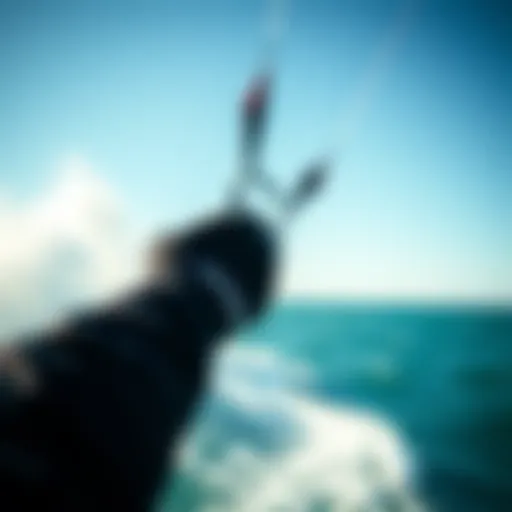Choosing the Right Wake Surf Board Size


Intro
Wake surfing has emerged as a thrilling water sport, drawing enthusiasts into its embrace. However, the magic of this experience isn't solely about riding the waves; a significant factor lies in the wake surf board size. Choosing the right board is not merely a matter of preference, but a decision that can enhance—or hinder—your entire experience on the water. With countless options available, understanding how board size correlates with riding style, skill level, and personal attributes becomes paramount. In this guide, we delve into the intricate world of wake surf boards, focusing on size and its implications for those who wish to carve perfect lines on the water.
Selecting an appropriately sized board can make the difference between gliding effortlessly over the waves and tumbling into a less-than-graceful plunge. Whether you're just embarking on your surfing journey or you've mastered advanced techniques, grasping the essentials of board sizes is essential for optimal performance and enjoyment.
Techniques and Tips
Essential Surfing Techniques for Beginners
For those new to wake surfing, building a strong foundation is crucial. Here are some key techniques to consider:
- Body Positioning: Maintain a balanced stance with your knees slightly bent. Feet should be planted shoulder-width apart on the board.
- Weight Distribution: Shifting your weight slightly back towards the tail of the board will help you create speed and maintain stability.
- Rope Handling: Hold the handle with both hands, arms extended but relaxed, allowing for a smoother pull from the boat.
- Reading the Wake: Focus on the boat's wake. It’s where you'll find the best waves for riding.
- Practice Getting Up: As the boat takes off, keep your knees bent and pull the rope towards you, allowing the board to find its balance under you.
Starting with these basics can make the experience enjoyable and possibly land you your first ride. It's essential to embrace the learning curve—everyone has taken a tumble or two!
Advanced Maneuvers for Experienced Surfers
Once you're comfortable on the water, it’s time to push your boundaries with some advanced techniques:
- Shuvits: A trick that involves flipping the board 180 degrees while staying on it.
- 360 Spins: This requires solid control and confidence; a smooth twist in the air can impress anyone watching.
- Rooftop Rides: Riding the crest of the wave can provide thrilling moments but requires precise timing and technique.
- Riding Switch: This involves changing your stance to ride in the opposite direction, challenging your balance and skills.
These advanced moves can take your adrenaline levels up a notch, but it’s wise to master the basics first. Remember, practice makes progress!
Gear and Equipment
Choosing the right gear is as vital as mastering techniques; you could say it’s the backbone of your surfing experience.
Top Surfboards of the Year: Comprehensive Reviews
When selecting a wake surf board, it’s important to know what’s hot in the market. Popular choices often include brands like Liquid Force, Hyperlite, and Ronix. These boards cater to a range of skill levels and preferences:
- Liquid Force Rocket: Suitable for beginners—its wide shape provides stability and forgiveness.
- Hyperlite Landlock: Ideal for larger riders, this board’s volume helps in maintaining buoyancy.
- Ronix Koal Classic: A versatile board that excel in performance and allows experienced surfers to push their limits.
Each of these options represents a different aspect of wake surfing, thus it’s wise to consider your skills and preferences before making a purchase.
Must-Have Accessories for Every Surfer
Don't overlook the importance of accessories; they can greatly enhance your wake surfing experience:
- Life Jacket: Safety should always come first.
- Sun Protection: High-SPF sunscreen or rash guards can prevent sunburn.
- Wake Surf Rope: A shorter, thicker rope is ideal for getting closer to the wake.
- Board Bag: Keeps your board safe from scratches and dings during transport.
Considering these aspects can ensure you have everything you need to ride the waves in style.
"The right board size not only boosts performance but can turn a regular surf day into an unforgettable adventure."
As we progress through this guide, we'll explore factors influencing board size decisions. Understanding these criteria will be crucial in helping surfers, whether novices or veterans, navigate their options in the world of wake surfing.
Understanding Wake Surfing
Wake surfing could be thought of as the perfect blend of thrill and technique, where riders harness the waves generated by a boat to enjoy a ride like no other. Unlike traditional surfing, where paddling out is a prerequisite, wake surfing allows surfers to start directly from the boat, bringing a unique dynamic to the sport. This accessibility opens the door for both beginners and seasoned surfers to test their skills on the water, making it an attractive option for a wide range of enthusiasts.
The significance of grasping the concept of wake surfing lies in understanding the techniques and nuances involved. This knowledge not only enhances one's ability to navigate the waves but also shapes the overall experience while riding. From the perfect stance to how to use the wake effectively, these elements come together, creating a rich tapestry of skills needed for success.
Key considerations for those diving into wake surfing include:
- Equipment Familiarity: Knowing the difference between various boards and understanding how size can impact performance can dramatically elevate a surfer's skill set.
- Riding Techniques: Learning efficient turns, tricks, and maintaining control over the board are fundamental.
- Safety Practices: This sport comes with its risks, and being educated about safety gear and practices ensures hours of fun without unnecessary hazards.
Ultimately, a solid foundation in wake surfing paves the way for a more enjoyable and rewarding experience on the water.
The Concept of Wake Surfing
At its core, wake surfing is about catching the wave produced by a boat without being tethered to it with a rope. This uncoupling from traditional towing marks a pivotal shift in how surfers interact with the water. Riders can effortlessly glide along the wave’s face, making maneuvers that showcase their skill and grace. Imagine riding an invisible line, dancing with the water as the boat pulls away, freeing the surfer to explore their boundaries.
The beauty of wake surfing is not just in the ride but in the versatility it offers. Riders can adapt their style depending on the wave's shape created by the boat, enabling a different experience each outing. Moreover, the camaraderie amongst wake surfers is palpable; sharing tips, techniques, and tricks has given rise to a bubbling community that thrives on collaboration and support. A key part of surfing successfully is knowing how to adjust to the mindset of the sport, where patience and persistence must be balanced with creativity and awareness.
The Evolution of Wake Surf Boards
Wake surf boards have come a long way since their inception. Initially, these boards were essentially repurposed shortboards designed for traditional surfing. However, as the popularity of wake surfing grew, manufacturers began to tailor boards specifically for this unique experience. Changes in materials and design features have led to boards that are lighter, more buoyant, and markedly easier to maneuver on the wake.
Modern designs incorporate varying shapes and sizes, catering to different skill levels and riding styles. For instance, fish-style boards offer excellent maneuverability and are often favored by advanced riders who enjoy performing tricks, while wider longboards provide stability and are ideal for beginners looking to find their footing on the water.
Over the years, innovation in technology, like the introduction of advanced materials for better performance, has played a crucial role in refining the experience. As more surfers hit the wake, board makers continue to experiment, ensuring that new designs meet the needs of this diverse community. By understanding these evolutionary elements of wake surf boards, aspiring surfers can make more informed decisions on which board aligns with their riding aspirations.
"The right board can be the difference between a good ride and an extraordinary adventure on the water."
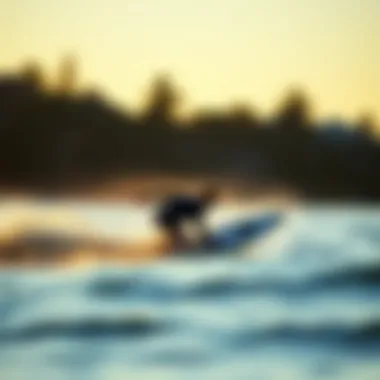
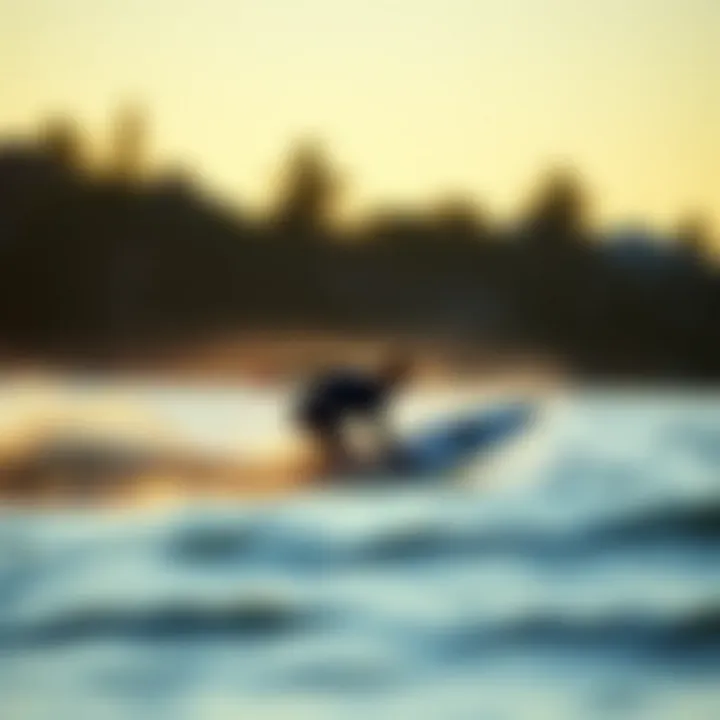
In summary, understanding wake surfing isn’t merely about the act of riding but delves into all aspects of the sport, including equipment, technique, safety, and community. This foundational knowledge is indispensable for anyone looking to engage with wake surfing on a deeper level.
Importance of Board Size
Choosing the right size for a wake surf board isn’t merely a matter of preference; it can significantly impact the overall experience on the water. Whether a novice trying to catch their first wave or a seasoned rider seeking to execute complex tricks, board size plays a crucial role in performance, stability, and maneuverability. Riders should understand that this choice involves much more than just picking the prettiest board on the rack or going by the latest trend. Let's dig into the various elements that underscore the importance of board size in wake surfing.
Impact on Performance and Stability
Board size directly correlates with performance outcomes and stability in the water. A larger board generally provides more surface area, which helps prevent sinking and aids stability, especially for beginners still mastering their balance. Conversely, a smaller board offers less flotation, demanding greater skill and control. This means that while a bigger board is usually more forgiving, it can hinder experienced riders when making sharp turns or navigating complex maneuvers. Riders need to ask themselves questions like:
- What is my current skill level?
- Am I looking to improve my skills or maintain a leisurely ride?
- How much stability do I need as I practice carve turns or take off?
Thus, a savvy selection of board size can mean the difference between a smooth, enjoyable session on the water and a frustrating experience of struggle.
"Choosing the right board size can either lift your performance to new heights or weigh you down with challenges."
Influence on Maneuverability
Another pivotal aspect of board size is its effect on maneuverability. Smaller boards are often designed to be agile and responsive; these are the ideal choices for advanced riders who relish quick turns, spins, and tricks. If a rider's goal is to pull off aerial jumps or transition smoothly between different riding styles, a shorter board helps in achieving those objectives. Smaller boards decrease drag, allowing for quicker reflexes and better control.
On the other hand, larger boards can be heavy and less prone to quick movements. They might make those thrilling tricks feel out of reach, partly because they require stronger physical exertion to manipulate. The contrast between a fish-style board and a longboard, for instance, highlights this dynamic. Fish-style boards cater to riders looking for speed and agility, perfect for carving those smooth lines on the wake.
Some considerations regarding maneuverability include:
- Type of tricks preferred (e.g., jumps vs. fluid turns)
- Anticipated riding conditions (e.g., calm lakes vs. choppy waters)
- The rider's physical fitness and experience level
Finding the right balance of size, style, and rider capability is key to maximizing one’s enjoyment and skill advancement while wake surfing.
Factors Influencing Board Size Selection
Understanding the factors that influence board size selection is key to ensuring an enjoyable wake surfing experience. Each rider is unique, and the demands of different riding styles require careful consideration of specific elements such as weight, skill level, and individual preferences. Adapting to the characteristics of the board can vastly improve performance and stability on the water.
Rider Weight Considerations
When it comes to selecting a wake surf board, rider weight plays a pivotal role. Heavier riders naturally require larger boards to maintain buoyancy and stability when surfing. Conversely, lighter individuals may find that smaller boards provide a more responsive ride, allowing them to maneuver with agility. The general rule of thumb suggests that if a rider weighs around 150 pounds, a board length of about 5'2" may suffice. However, as the rider's weight increases to, say, 200 pounds, a board of at least 5'6" is often recommended.
It's not just about the pure numbers; there's a finesse involved here. A heavier board may seem appealing for stability, but it could hinder performance for a lighter rider seeking tricks and spins. Conversely, a weighty rider on a petite board might feel like they're attempting to balance on a seesaw during a storm.
Skill Level Adaptations
Skill level should not be overlooked when zeroing in on board size. Beginners often benefit from larger boards that provide greater surface area and better flotation. This helps them gain confidence as they learn. In contrast, more advanced surfers tend to opt for shorter and narrower boards that allow for sharper turns and increased speed. The trade-off is clear: while a larger board facilitates learning, it may restrict the performance of an experienced surfer wishing to execute tricks.
It's also essential for riders to be aware of their progression. As one’s skills elevate, it might be wise to downsize the board gradually. This could mean adjusting from a beginner’s board of around 6' to a performance board that's approximately 5’4" or less, catering to the more energetic demands of a seasoned rider.
Riding Style Impacts
Lastly, riding style profoundly influences board size. For someone who thrives on mellow rides and enjoys gliding effortlessly on waves, a larger, wider board is typically a strong choice. This kind of board supports cruising and provides a stable platform for relaxed things like trick attempts at low speeds.
On the other hand, aggressive riders, known for their aerial tricks, might find a shorter, more maneuverable board fits their game better. With less surface area on the water, these boards facilitate quicker pivots and sharper cuts, essential for any daring aerial maneuver.
Wake Surf Board Size Chart
Choosing the proper wake surf board size is crucial for optimal performance on the water. A well-sized board contributes significantly to stability, maneuverability, and the overall riding experience. This section will articulate the dimensions and considerations that every surfer should keep in mind. The size chart broadly categorizes boards based on rider weight, enabling individuals to make informed decisions tailored to their specific needs.
Overview of Size Specifications
When we talk about size specifications, it's not just about length. The width, tail shape, and rocker profile all play a role in how the board behaves in the water. Generally, longer boards yield more stability, making them suitable for beginners or heavier riders. Meanwhile, shorter boards are designed for agility and performance, favored by more experienced surfers.
This is where understanding size specifications provides a distinct advantage. For example, a board that is 5.8 feet long with a 22-inch width may offer a different riding experience than a board that measures 4.9 feet and 19 inches wide. Each dimension can alter how the board interacts with the wake, leading to varied performance outcomes. Keep this in mind when selecting a board to align it with both skill level and intended style.
Recommended Sizes Based on Rider Weight
Lightweight Riders
Lightweight riders often find themselves at a unique advantage when it comes to board selection. Generally, those under 150 pounds would benefit from boards measuring around 4.5 to 5.5 feet. This is because a lighter board responds quicker and grants enhanced maneuverability, making it easier to catch waves and practice tricks. It's like riding a bicycle that’s carefully crafted for your weight—every push has a direct impact.
However, lighter boards may lack some stability in choppy conditions. Thus, while ideal for performance turns, beginners may want to consider a slightly larger board to help maintain balance.
Average Weight Riders
For most riders between 150-200 pounds, a board size between 5.6 to 6.2 feet is typically recommended. Average weight riders can take advantage of this range to find a balance between maneuverability and stability. These boards grant flexibility in tricks while still providing enough surface area for a stable ride. It’s like finding that sweet spot in any activity—where you can achieve great results without feeling overwhelmed.
But it’s worth considering that, depending on the riding style—whether you prefer long rides or practicing spins—this category can branch off into different shapes and designs that suit personal tastes. For those who venture into aggressive riding, a slightly longer board may serve better.
Heavier Riders
For riders above 200 pounds, boards of about 6.0 to 6.5 feet or more are often recommended. Such boards provide the much-needed buoyancy to accommodate the additional weight. They are designed to maintain a high level of stability while riding, permitting riders to enjoy a smooth experience on the water, even with challenging wakes. Heavyweights can get lost in the fun without worrying too much about sinking or losing balance.


There's a common misconception that heavier boards correlate only with sluggish rides, but with the correct design, the experience can be surprisingly spry. The wider stance allows for a strong paddle and reliable launch off the wake, leading to exhilarating rides—without the fear of tipping over.
Board Length and Width Correlation
The relationship between a board's length and width cannot be understated. A longer board paired with a wider width alters the board's overall buoyancy, which plays a pivotal role in how it interacts with the water's surface. As the length increases, the surface area also expands, making it easier to stay afloat while enhancing stability. Conversely, a shorter and narrower board might sink more easily, making it more responsive but yielding a different kind of challenge in choppy waters.
The thicknes of the board also needs consideration. Thicker boards hold more float, yet they can feel sluggish at higher speeds. A rider's weight and style preferences ultimately dictate the best configuration.
Understanding these variables can aid riders immensely in making selections that truly fit their surfing ambitions. In essence, the right board size not only improves performance but also enhances safety and enjoyment on the water.
Types of Wake Surf Boards
The selection of the right wake surfboard can greatly influence the quality of your ride, and understanding the various types available is essential for both beginners and seasoned surfers alike. Different shapes and sizes cater to distinct riding styles, skill levels, and water conditions. Here, we’ll dissect the primary categories of wake surfboards: Fish Style Boards, Longboards, and Shortboards. Each type brings unique characteristics that can either enhance or limit your performance on the water.
Fish Style Boards
Fish style boards often appeal to surfers seeking agility and speed. These boards are typically shorter and wider than standard options, featuring a distinctive swallow tail design that allows for quick turns and fancy maneuvers.
One of the essential traits of fish style boards is their ability to generate speed with less effort. When you’re catching a nice wave, the added width provides extra surface area, giving the rider stability. If you weigh less or prefer a more playful style in your wake surfing, a fish style board could be a top pick.
- Benefits:
- They’re agile, making them great for tricks.
- Higher surface area gives excellent buoyancy.
- Ideal for smaller waves while still offering turns.
However, it’s worth noting that while they excel in maneuverability, fish style boards might feel a bit loose on the water if not handled correctly. Some riders might find that they need to adjust their riding technique to suit the board’s characteristics, so it’s essential to spend time getting comfortable on it.
Longboards
Longboards, quite the opposite of fish style boards, offer a stable and smooth glide for riders. They usually range from 5’8" to 11’ long, providing significant length that facilitates easy paddling and catching waves. For those still finding their footing in the world of wake surfing or wanting a leisurely ride, longboards are often recommended.
What makes longboards particularly appealing is the fluidity of their movement. You can effortlessly cruise across the wake, enjoying an almost surf-like experience on water.
- Pros:
- They offer stability for beginners.
- Excellent for larger swells, as they catch waves efficiently.
- Promote smoother rides, allowing for a relaxed experience.
Yet, while they shine in stability, longboards can feel cumbersome for more advanced riders. If you’re eager to perform aerial maneuvers or quick spin tricks, you might want to consider other options, as the length can limit quick transitions.
Shortboards
Shortboards are designed with advanced riders in mind, offering a smaller profile that promotes quick and agile movements on the water. Generally shorter than longboards, these boards emphasize performance over versatility.
The sharp edges and refined contours of shortboards allow for sharp turns and explosive surf styles that thrill many experienced riders. If you’re one who enjoys carving and cutting through the wake at high speeds, a shortboard will likely meet your expectations.
- Drawbacks:
- They require more skill to handle effectively.
- Less stability can make them tricky for beginners.
- Not the best option for larger waves or riders who prefer a more laidback style.
Common Misconceptions about Board Sizes
In the world of wake surfing, when talk turns to board sizes, many thoughts bubble to the surface. Misunderstandings run rampant, leading to decisions that could hinder one's experience on the water. The nuance of choosing the right board size can be a game-changer, not only for performance but also for confidence and smooth gliding across the waves. Therefore, it’s crucial to dissect these misconceptions and set the record straight.
Size Equals Skill Level
One common belief is that board size is directly proportional to a rider's skill level. Some newcomers feel pressured to choose a larger board, thinking it will magically improve their balance and skills. While it is true that larger boards can provide a more stable ride for beginners, since they float better and are easier to handle, this is not a one-size-fits-all solution.
Understanding a rider's unique style and comfort is essential. For instance, a beginner who is confident and wishes to learn tricks might prefer a shorter board to facilitate more maneuverability. Therefore, opting for a board based solely on the idea that size equals skill can lead to frustration rather than empowerment on the wake.
"The right board does not define a surfer's ability; it enhances it."
It's also worth noting that many professional riders often choose shorter boards despite their high skill levels. They value agility and responsiveness over mere stability. Thus, it’s imperative to match board size with individual goals and styles rather than making assumptions based on skill alone.
Larger Boards Always Offer Better Stability
The belief that larger boards always provide better stability is another misconception that needs careful consideration. While larger boards indeed have more surface area and, consequently, can offer a steadier platform for beginners, that doesn't necessarily translate to optimal performance for every situation or rider.
Larger boards can be cumbersome and may not be suitable for advanced techniques that require quick, sharp turns. In contrast, a smaller board allows for more responsive movements, making it easier to perform tricks, but lacks some of the surface area that provides a cushion on choppy waters.
Moreover, various board shapes influence stability. For instance, a wider fish style board may offer more stability than a longer, narrower one, even if the latter is larger overall. Thus, it is vital to consider the type of riding you plan to do when selecting board size.
When learning, it’s also essential to focus on developing good habits and refining skills over time. As a rider gains confidence and technique, transitioning to a size that suits their evolving style will often yield better results.
Testing and Choosing the Right Board
Selecting the right wake surf board can seem like searching for a needle in a haystack, especially given the multitude of shapes, sizes, and designs available today. This process is not just about finding a board that looks good on the water; it’s about finding one that complements your unique riding style, skill level, and physical characteristics. Whether you are an eager novice or a seasoned rider, understanding the significance of testing various boards can drastically enhance your wake surfing experience.
Trialing Different Sizes
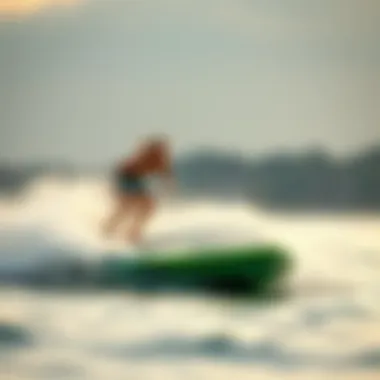
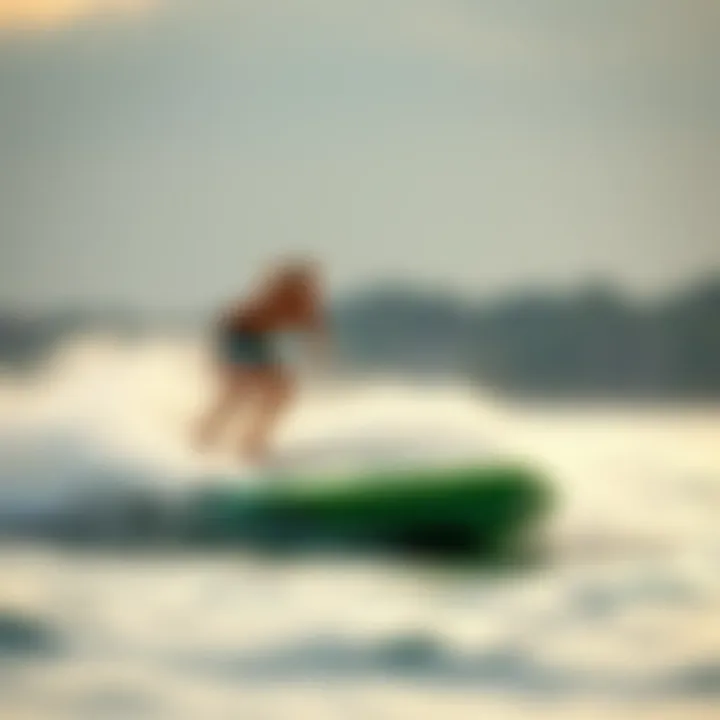
When it comes to choosing a wake surf board, trialing different sizes is paramount. You wouldn’t buy a pair of shoes without trying them on, would you? The same principle applies here. The right board not only guarantees comfort but can also affect your performance dramatically.
A few points to consider about different sizes include:
- Feel and Comfort: A board that is too small or too large can hinder your balance and stability, making the experience less enjoyable. Testing allows you to feel how the board reacts to your movements and weight distribution.
- Performance Variables: Smaller boards often allow for quicker turns and tricks, appealing to more skilled riders, while larger boards provide stability, which is especially beneficial for beginners. By trying various sizes, you’ll see firsthand how each option influences your riding ability.
- Environmental Dependent: Different wave conditions can call for different board sizes. What might feel comfortable in calm waters could be challenging in choppy waves. Trialing boards under various conditions helps you understand these dynamics better.
Visiting rental spots or surf schools can provide access to boards in diverse sizes. Take a few hours, experiment, and truly feel how each board performs beneath you.
Engaging with Local Communities
Another layer to making an informed choice about your board involves engaging with local wake surfing communities. Connecting with others who share your passion can open a treasure trove of insight and practical advice that you may not find in guides or forums. Consider the following benefits:
- First-Hand Experiences: Members of the community often share their experiences with different boards, saving you from costly missteps. It’s like having a personal recommendation from someone who’s tread the waters ahead of you.
- Board Swaps and Demos: Many surf clubs host events allowing enthusiasts to test various boards. This can be a goldmine—not just for testing boards, but also for making connections and sharing tips.
- Learning Opportunities: Local communities often organize clinics or coaching sessions, focusing on both technique and equipment. Engaging can lead to valuable knowledge about what works best in different surfing contexts.
In short, don’t underestimate the importance of social interaction in this sport. Whether via forums on platforms like Reddit or local gatherings, engaging with fellow surfers can illuminate paths to better boards and more enjoyable rides.
Choosing the right board isn't just a solo journey; it’s also about tapping into the collective wisdom around you.
The decision-making process for selecting a wake surf board isn’t meant to be rushed. Experiment with different size boards and immerse yourself in local surfing culture. This will not only enhance your understanding but also ease your path to finding the perfect wake surf board suited for your unique riding style.
Expert Recommendations
When it comes to wake surfing, guidance from professionals really matters. It’s not just about getting on the water; it’s about understanding the ins and outs of your gear, especially the board you choose. Experts provide insights drawn from years of experience, helping both newbies and seasoned riders make informed decisions. This section aims to unpack those valuable recommendations and offer a glimpse into the strategies the pros use to elevate their performance.
Insights from Professional Riders
Professional riders have a keen sense of how board size affects performance in subtle, yet significant ways. They often emphasize that there’s no one-size-fits-all when it comes to selecting a board. Instead, various factors come into play, such as rider weight, skill levels, and personal riding style. For instance, anecdotal evidence suggests that a heavier rider may benefit from a slightly longer board to provide extra stability—which can be crucial when tackling those big waves.
To illustrate this point, consider the feedback from a professional wake surfer who prefers a 5’6" fish board for its agility and fun ride but switches to a 6’0" longboard when teaching beginners. This adjustment not only accommodates different weight classes but also enhances control. It’s the experience of these pros that allows them to maintain an edge over competitors—by tweaking small details like board length, they can significantly improve their experience.
In a sense, professional riders act as living examples of the various combinations of board sizes and styles, showing that experimentation and adaptability are key elements in mastering wake surfing.
Reflections on Board Design Trends
The world of wake surfboards is not static; it continuously adapts, influenced by the latest technological advancements and rider demands. Professional riders often reflect on these trends and how they align with their needs on the water. For instance, recent boards have seen advances in materials that increase durability while still being lightweight. Riders commonly note that boards designed with composite materials can yield faster speeds and improved responsiveness. That’s critical when trying to catch waves just right.
Apart from materials, the shapes have also evolved. The ongoing trend favors wider tails for increased stability and enhanced lift. Experienced surfers find that this design allows for smoother transitions when changing directions, making it easier to perform tricks or maintain speed on a wave. Professional insight into these design changes can guide consumers when considering their purchase options.
"Choosing the right board means blending personal preference with the principles of design. What works for one might not work for another, but understanding why is where you’ll thrive."
By paying attention to these evolving trends, enthusiasts can remain informed and poised to make choices that truly align with their surfing style. Those insights, combined with personal experimentation, facilitate richer and more enjoyable experiences in wake surfing.
Maintaining Your Wake Surf Board
Maintaining your wake surf board is essential for ensuring a long lifespan and optimal performance on the water. Like any equipment, neglect can lead to irreversible damage, making the investment in a quality board feel rather wasted. Therefore, proper care not only preserves the physical integrity but also enhances the overall riding experience. The best thing? Most maintenance tasks are simple and can be regularly performed to avoid bigger headaches later.
Cleaning and Care Guidelines
Cleaning your wake surf board might seem simple, but it involves some key practices that shouldn’t be overlooked. Here’s a rundown:
- Freshwater Rinse: After each session, rinse your board with fresh water to wash away salt, sand, and grime. This step prevents buildup that can deteriorate the material over time.
- Use Soft Cloths: When wiping down your board, use microfiber cloths or soft materials. Avoid harsh fabrics that could scratch or scrape the surface.
- Inspect for Damage: While cleaning, take the opportunity to examine your board closely. Look for cracks, dings, or delaminations. Early detection can often mean easy repairs rather than costly replacements.
- Avoid Harsh Chemicals: Cleaning products filled with acids or solvents can lead to discoloration and material degradation. Stick to mild dish soap mixed with water for the best results.
Furthermore, if your board has any traction pads or grip tape, remember to clean these regularly as well. Organic materials and oils from feet can build up, reducing grip when riding. A simple scrub with a brush can usually clear that away effectively.
Storage Best Practices
Proper storage is just as critical as cleaning for maintaining your surf board. Think of it this way: the environment where your board rests impacts its condition just as much as the water in which it surfs. Here’s how you can store it safely and efficiently:
- Cool, Dry Place: Store your board in a temperature-controlled environment. Both excessive heat and cold can warp materials. Avoid leaving it in your car or in direct sunlight for prolonged periods.
- Use a Board Bag: Investing in a padded bag can offer protection from physical impacts during transportation and storage. A good bag can shield the board from dust and scratches.
- Position It Correctly: Always store the board flat rather than vertical. If it’s kept on end for long periods, the pressure can lead to warping or damage.
- Avoid Damp Areas: Moist environments can encourage mold growth and deterioration of materials, especially if your board has wooden elements. Ensure the board is stored somewhere dry and clean.
By following these steps, you'll ensure that your wake surf board remains in prime condition, allowing you to enjoy every ride to the fullest, without worrying about the equipment.
"A well-maintained board isn’t just about aesthetics; it’s your ticket to a smoother ride and a safer surfing experience."
Ending
Selecting the right wake surf board size is paramount in enhancing your overall surfing experience. Understanding how board size affects various performance factors like stability, maneuverability, and the feeling on the wave can make or break your time out on the water.
Recapping Board Size Selection
As we have seen throughout this guide, several key factors dictate the ideal board size for a rider. These include rider weight, skill level, and personal riding style:
- Rider Weight Considerations: Heavier riders typically benefit from a larger board, providing better stability and support. In contrast, lighter riders may find smaller boards easier to handle and perform tricks on.
- Skill Level Adaptations: Beginners usually fare better on wider, longer boards that offer more buoyancy, while more seasoned surfers often prefer shorter, sleek models that allow for sharper turns and advanced maneuvers.
- Riding Style Impacts: Those who prefer a laid-back, cruising style may opt for a longboard, while adrenaline junkies might lean towards shortboards for high-speed tricks and jumps.
Assessing these elements ultimately leads to thoughtful board size selection. It means paying close attention not only to numbers but also to your personal experience and comfort in the water. Having the right size board is like finding the perfect pair of shoes; when it fits just right, everything feels effortless.
Encouragement for Continued Exploration
Cementing your knowledge about wake surf board sizes doesn’t just stop here. The world of wake surfing is ever-evolving, with new designs and materials constantly hitting the market. To truly master this sport, keep exploring. Engage with your local surfing community, follow industry developments, and even participate in forums such as reddit.com to exchange insights.
Consider experimenting with different boards based on what you’ve learned. Borrow from friends or test out boards at retail shops. This hands-on approach, coupled with your newfound wisdom about board sizing, can help refine your preferences and enhance your skills.
Remember, every wave presents a unique challenge, and having the right surf board can make all the difference. Embrace the journey of learning and improvement; the more you immerse yourself in the sport, the more fulfilling your time on the water will become. So, strap on that board and ride the wave of adventure!

